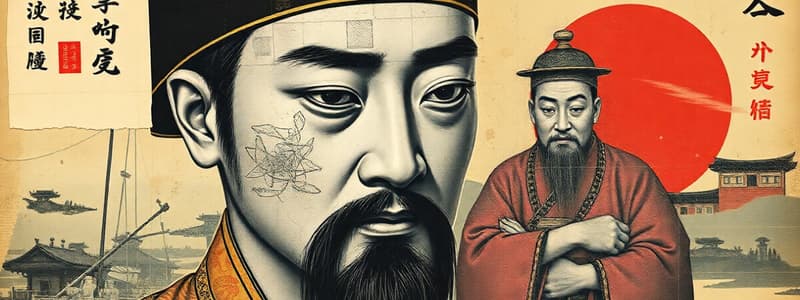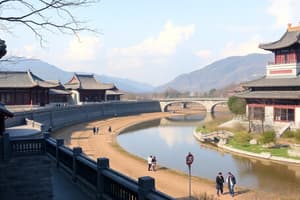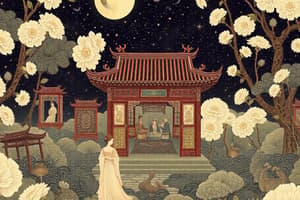Podcast
Questions and Answers
What was a primary reason for China's trade desirability during the Song Dynasty?
What was a primary reason for China's trade desirability during the Song Dynasty?
- The production of bronze goods
- The reliance on foreign military alliances
- The abundance of agricultural surplus
- The continued exchange of luxury goods (correct)
Which of the following practices became popular among upper-class women during the Song Dynasty?
Which of the following practices became popular among upper-class women during the Song Dynasty?
- Wearing elaborate headdresses at public events
- Foot binding as a sign of feminine beauty (correct)
- Tattooing as a symbol of beauty
- Participating in competitive sports
What significant conflict did the Song Dynasty face that contributed to its decline?
What significant conflict did the Song Dynasty face that contributed to its decline?
- A trade deficit with foreign powers
- Revolts from within the ruling class
- Losing northern territory to the Jin Dynasty (correct)
- A civil war with neighboring states
What was required from kingdoms wishing to trade with the Song Dynasty?
What was required from kingdoms wishing to trade with the Song Dynasty?
Which dynasty conquered the Song Dynasty in 1279?
Which dynasty conquered the Song Dynasty in 1279?
How many years span the dates 2100 BC and 1912 AD?
How many years span the dates 2100 BC and 1912 AD?
What was a significant achievement of the Sui Dynasty?
What was a significant achievement of the Sui Dynasty?
What was one major outcome of the Tang Dynasty's administrative reforms?
What was one major outcome of the Tang Dynasty's administrative reforms?
What crop contributed significantly to the population increase during the Tang Dynasty?
What crop contributed significantly to the population increase during the Tang Dynasty?
Which dynasty preceded the Tang Dynasty?
Which dynasty preceded the Tang Dynasty?
Which two groups did the Tang Dynasty notably engage with through expansion efforts?
Which two groups did the Tang Dynasty notably engage with through expansion efforts?
What philosophical movement is associated with the Tang Dynasty?
What philosophical movement is associated with the Tang Dynasty?
Which of the following was a reason for the Sui Dynasty's decline?
Which of the following was a reason for the Sui Dynasty's decline?
What was the main reason for the Tang dynasty's persecution of Buddhism?
What was the main reason for the Tang dynasty's persecution of Buddhism?
What was the main goal of the Tang Dynasty's ‘cleansing’ of foreign beliefs?
What was the main goal of the Tang Dynasty's ‘cleansing’ of foreign beliefs?
What significant event marked the beginning of the decline of the Tang Dynasty?
What significant event marked the beginning of the decline of the Tang Dynasty?
What was the Song Dynasty's approach to the continuation of Neo-Confucianism?
What was the Song Dynasty's approach to the continuation of Neo-Confucianism?
What significant innovation marked the Song Dynasty's emphasis on maritime ventures?
What significant innovation marked the Song Dynasty's emphasis on maritime ventures?
Which of these innovations can be attributed to the Song Dynasty?
Which of these innovations can be attributed to the Song Dynasty?
What was the significance of the Song Dynasty's focus on commercial practices?
What was the significance of the Song Dynasty's focus on commercial practices?
What can we infer about the Song Dynasty based on their innovations in technology and commerce?
What can we infer about the Song Dynasty based on their innovations in technology and commerce?
Flashcards
Sui Dynasty
Sui Dynasty
A short-lived dynasty that unified China after the Han Dynasty, and laid the groundwork for future dynasties.
Imperial Confucian Examination System
Imperial Confucian Examination System
A centralized system for selecting government officials based on merit through examinations.
Grand Canal
Grand Canal
A massive canal linking northern and central China, constructed during the Sui Dynasty.
Tang Dynasty
Tang Dynasty
Signup and view all the flashcards
Champa Rice
Champa Rice
Signup and view all the flashcards
Neo-Confucianism
Neo-Confucianism
Signup and view all the flashcards
Tang Dynasty's Golden Age
Tang Dynasty's Golden Age
Signup and view all the flashcards
Tang Dynasty's Territorial Expansion
Tang Dynasty's Territorial Expansion
Signup and view all the flashcards
Tribute System
Tribute System
Signup and view all the flashcards
Foot Binding
Foot Binding
Signup and view all the flashcards
Mongols
Mongols
Signup and view all the flashcards
Yuan Dynasty
Yuan Dynasty
Signup and view all the flashcards
Tang Dynasty and Buddhism
Tang Dynasty and Buddhism
Signup and view all the flashcards
Motivations for Tang Dynasty's Persecution of Buddhism
Motivations for Tang Dynasty's Persecution of Buddhism
Signup and view all the flashcards
Song Dynasty: Maritime Ventures
Song Dynasty: Maritime Ventures
Signup and view all the flashcards
Song Dynasty: Standing Navy
Song Dynasty: Standing Navy
Signup and view all the flashcards
Song Dynasty and Neo-Confucianism
Song Dynasty and Neo-Confucianism
Signup and view all the flashcards
Song Dynasty: Innovations
Song Dynasty: Innovations
Signup and view all the flashcards
Song Dynasty: Early Industrial Revolution
Song Dynasty: Early Industrial Revolution
Signup and view all the flashcards
Study Notes
Warm-up Calculation
- 2100 BCE to 1912 CE spans 4011 years.
- Calculation formula: BC Year + AD Year - 1
Sui Dynasty (581-618 CE)
- Short-lived but pivotal dynasty, similar to the Qin.
- Unified Han peoples under a centralized administration for the first time since the Han Dynasty.
- Established a lasting state system by implementing a merit-based Confucian examination system for bureaucracy.
- Initiated large-scale public works projects, including the Grand Canal, linking northern and central China's economies.
- Overly ambitious public works and military campaigns likely shortened its lifespan, however, set the stage for a stable, centralized state.
Tang Dynasty (618-907 CE)
- Ushered in a period of cultural and territorial growth, considered a high point in Chinese history.
- Consolidated control through administrative reforms:
- Developed and continued the examination system.
- Reduced bureaucratic positions.
- Successful early on in acquiring territory through marriage and diplomacy (Turkish nomadic groups).
- Introduced Champa rice, a drought-resistant strain from modern-day Vietnam, leading to population growth.
- Expansion was eventually halted in Korea and by alliances of Turks and Arabs.
- Exceeded the territorial extent of the Han Empire.
Tang Dynasty Legacy
- Promoted Confucianism's development (Neo-Confucianism).
- Figures like Han Yu reinvigorated Confucianism, removing some mystical elements
- Promoted and consolidated its spread by suppressing Taoism and Buddhism.
- Emperor Wuzong persecuted, confiscated, and destroyed Buddhist temples, monks, and relics due to some financial motivations (military campaigns).
Song Dynasty (960-1279 CE)
- Unified most of China after the Tang Dynasty's collapse.
- Smaller than Tang, but continued flourishing in several areas:
- Cultural, academic, technological, literary, economic, and militaristic innovations.
- Neo-Confucian belief systems
- Examination systems.
- Emphasis on maritime ventures (both militaristic and economic) for the first time in world history.
- State-endorsed commercial practices.
- Establishment of the Maritime Trade Supervisorate.
- Implementation of taxes on imports and encouragement of commerce and trade.
- Establishment and maintenance of the first standing navy for protection.
- Innovations in gunpowder and a true north compass.
- First use of paper money, widening trade, and assisting in the beginning of the Chinese Industrial Revolution.
- Luxury goods such as porcelain, silk, and tea were traded extensively leading to a large sense of worth/wealth for the Chinese.
- Advanced iron and steel goods
Song Dynasty Continued
- Required tribute from neighboring kingdoms for trade.
- Developed more clearly-defined tribute system including requirements from Korea, Japan, the steppe, and Southeast Asia.
- Confucian attitude of maintaining self-worth above other civilizations.
Song Dynasty Legacy
- Controversial legacy due to oppressive tributary practices.
- Growth in popularity of foot binding for upper-class women, marking a sign of feminine beauty.
- Struggles along the northern borders with the Jurchen-led Jin Dynasty.
- Gradual decline and loss of territory to the Mongols.
- Conquest and absorption by the Yuan Dynasty in 1279, ending the Song.
Studying That Suits You
Use AI to generate personalized quizzes and flashcards to suit your learning preferences.




